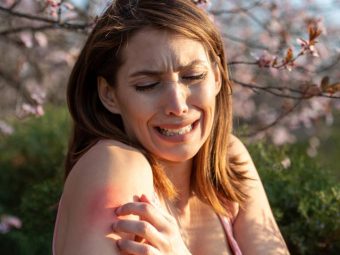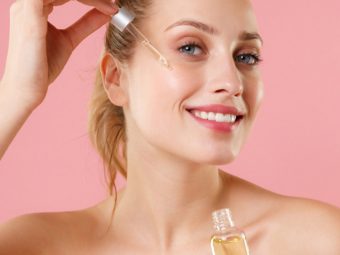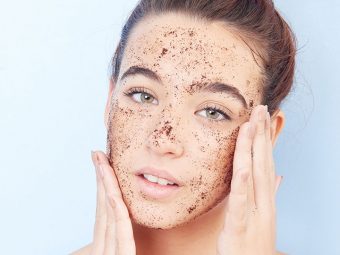[ad_1]
Sunburn is one of the most common causes of peeling skin. As the weather warms up, it may be tempting to lay out in the sun. But your skin reacts to the sun’s UV rays and burns if you don’t use sunscreen or sunblock, which may lead to sunburn peeling. Sunburn is caused by a variety of factors, including the length of time spent in the sun, the time of day, the intensity of UV radiation, your skin type, and the use of any topical or internal treatment. Sunburn not only causes skin peeling and irritation but also increases the risk of skin cancer. So what can be done to prevent it? Is there any way to get rid of it? We have answered everything in this article. Keep reading!
What Is Sunburn Skin Peeling?
The sun damages the skin cells in the epidermis when your skin is overexposed to the harmful UV rays. The immune system in your body that is trying to protect you from harm gets overwhelmed, resulting in the damaged skin peeling off (1).
Wondering how long your skin will peel after a sunburn? Keep reading to find out.
How Long Does It Take For Your Skin To Peel After Sunburn?
Thankfully, sunburn skin peeling is a type of short-term skin damage (1). Your skin can start peeling anywhere from three days to a week following a sunburn. In general, the peeling stops after the skin has fully recovered. The entire procedure could take up to two weeks.
Once the damage has been done, there is no way to completely prevent peeling. You can, however, aid in the maintenance and healing of the healthy skin underneath. How? Let’s have a look at the next section to find out!
How To Get Rid Of Sunburn Peeling Skin
1. Cold Compress, Cold Showers, And Cool Baths
Using a cold compress or taking a cool shower/bath will not guarantee that the peeling will subside. However, if your sunburn is especially hot, inflamed, and unpleasant, the cool temperatures may provide temporary relief.
You can make a cold compress at home by filling a thick cloth bag with ice cubes or wrapping ice cubes in a washcloth. Never apply ice directly to sunburned skin because the extreme cold may cause further harm to the skin, worsening peeling and delaying the healing process.
2. Aloe Vera Gel
Aloe vera gel applied topically calms and hydrates sunburned skin while also reducing inflammation (2). These combined properties help to speed up the healing process of sunburn and shorten the skin peeling time.
Apply the gel directly to your skin from aloe vera leaves or use a natural over-the-counter (OTC) aloe vera gel product. Avoid any store-bought aloe vera gel that contains chemical preservatives as it might aggravate irritation.
3. Oatmeal Bath
Colloidal oatmeal has anti-inflammatory properties (3). Therefore, it can relieve the dryness and irritation caused by sunburn. It also aids the skin’s ability to retain moisture, which helps in the process of healing.
Colloidal oatmeal is not the same as breakfast oatmeal. Nevertheless, whole oats can be used to make colloidal oatmeal. Put some uncooked whole oats in a food processor or blender and grind them to a fine powder. Pour 2-3 cups of this powder into a lukewarm or cool bath and soak in it for 10-15 minutes.
4. Wear Loose-Fitting Clothes
Sunburn and tight clothing make for an uncomfortable combination. Instead, wear loose, soft clothing to let your skin breathe and reduce the possibility of friction and further irritation.
5. Don’t Peel
One of the worst things you can do after a sunburn is peel off the excess skin. You risk causing an infection and exposing skin cells that are not ready to be exposed, which may result in scarring.
6. Take OTC Anti-Inflammatory Medication
Taking aspirin or ibuprofen, which are non-steroidal anti-inflammatory drugs, can help calm the skin and reduce some of the pain and swelling associated with sunburn. You can also apply an over-the-counter hydrocortisone cream to the affected areas (1).
You can also crush a few aspirin or ibuprofen tablets and mix them with water to make a paste that you can gently apply to the affected area.
Avoid petroleum or oil-based lotions and moisturizers until your skin stops peeling completely.
7. Stay Hydrated
It’s time to start working from the inside out to cure peeling skin, in addition to external treatments. To be honest, nothing is more beneficial to your skin than a big glass of water. Staying hydrated is essential for healthy skin. Water becomes even more necessary when your skin is damaged, such as after a sunburn.
8. Other Home Remedies
There is not a lot of scientific evidence to support the use of a few home remedies for sunburn. However, they are safe to use unless you are sensitive or allergic to them. You can try:
- Applying menthol shaving cream to the skin.
- Adding baking soda to a cool bath.
- Applying honey to the affected area.
We have included some tips in the following section to help you prevent sunburn peeling. Keep scrolling to know more.
How To Prevent Sunburn Peeling?
- Apply sunscreen that contains SPF 30 or more every two hours.
- Stay out of the sun as much as possible.
- Keep as much skin covered as possible with long-sleeved clothes, hats, and light scarves.
- Wear sunglasses and a wide-brimmed hat when stepping out.
- Drink plenty of fluids to prevent dehydration.
- Avoid tanning beds at all costs.
Sometimes, the skin peeling can get bad enough to require medical attention. Find out when you should consult a doctor in the next section.
When Should You See A Doctor?
Sunburn peeling is rarely a cause for concern and does not usually necessitate medical attention. However, you should get medical help if you notice any of the following symptoms:
- Swelling.
- Fluid oozing from the affected area
- Blisters that become inflamed or turn yellow.
- Fever, nausea, or chills.
Key Takeaways
- Sunburn can lead to irritation, redness, discomfort, and – in severe cases – peeling.
- Your skin may start peeling anywhere from three days to a week after getting sunburnt.
- Simple home remedies, like aloe vera gel and oatmeal baths, can help reduce inflammation, speed up healing, and reduce the severity and duration of peeling.
The Bottom Line
Skin peeling is a natural part of the healing process after sunburn. Simple home remedies – such as aloe vera and cold compress – can help reduce inflammation, speed up healing, and reduce the degree and duration of peeling.
Sunburn peeling seldom requires medical treatment. But if you develop symptoms such as nausea, fever, or serious blistering, or if you notice signs of infection, consult a doctor immediately.
Expert’s Answers For Readers’ Questions
Is peeling a sunburn bad?
Yes, you should avoid picking at burnt skin as it interferes with the healing process and can damage the healthy skin surrounding it. This may aggravate the pain and lead to infection.
Is Vaseline good for sunburn?
No, dermatologists advise against using oil- or petroleum-based products, such as Vaseline, as they can trap heat in your skin and aggravate sunburn.
How do you know if you have a second-degree sunburn?
The epidermis and dermis are both affected by second-degree burns. Such burns cause swelling and red, white, or splotchy patches on the skin. You may also develop blisters and excruciating pain. Scarring can result from second-degree burns that are too deep.
Sources
Articles on StyleCraze are backed by verified information from peer-reviewed and academic research papers, reputed organizations, research institutions, and medical associations to ensure accuracy and relevance. Read our editorial policy to learn more.
- The Risks of Tanning
https://www.fda.gov/radiation-emitting-products/tanning/risks-tanning - Aloe Vera: A Short Review
https://www.ncbi.nlm.nih.gov/pmc/articles/PMC2763764/ - Anti-inflammatory activities of colloidal oatmeal (Avena sativa) contribute to the effectiveness of oats in treatment of itch associated with dry irritated skin
https://pubmed.ncbi.nlm.nih.gov/25607907/
Related
LATEST ARTICLES
[ad_2]

















